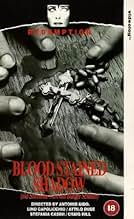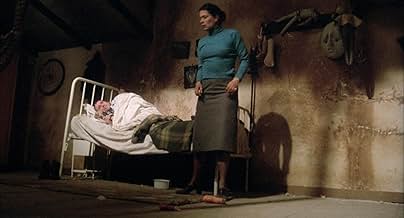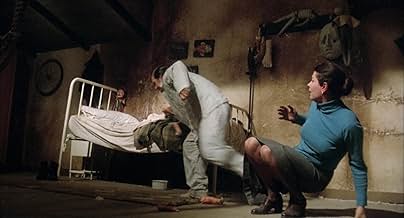NOTE IMDb
6,3/10
2,2 k
MA NOTE
Le corps d'une écolière est retrouvé dans une prairie. Le meurtrier n'est jamais arrêté et, des années plus tard, un jeune homme nommé Stefano retourne sur l'île et retrouve son frère, le pr... Tout lireLe corps d'une écolière est retrouvé dans une prairie. Le meurtrier n'est jamais arrêté et, des années plus tard, un jeune homme nommé Stefano retourne sur l'île et retrouve son frère, le prêtre local.Le corps d'une écolière est retrouvé dans une prairie. Le meurtrier n'est jamais arrêté et, des années plus tard, un jeune homme nommé Stefano retourne sur l'île et retrouve son frère, le prêtre local.
- Réalisation
- Scénario
- Casting principal
Craig Hill
- Don Paolo
- (as Graig Hill)
Alina De Simone
- Medium
- (as Alina Simoni)
Sonia Viviani
- Girl walking with Signora Nardi
- (as Sonia Vivani)
Fortunato Arena
- Antonio, Innkeeper
- (non crédité)
Antonio Bido
- Man at cemetary
- (non crédité)
Eolo Capritti
- Customer in restaurant
- (non crédité)
Avis à la une
Sounds a bit strange that Antonio Bido just had few movies as director until now, this second entry on Giallo where he co-wrote and directed, however was his final movie in this specific genre, here he brings a holy figure of the Church, a Priest Don Paolo (Craig Hill) when arrives nearby Venice his young brother Stefano (Lino Capolicchio) a professor stressed by strange visions of the past over an unsolved murder of a girl, Lino has an occasional meeting at train's cabin with Sandra (The eye candy Stefania Casini), Lino was received warmly by Don Paolo, implying a true fraternal feelings, the Priest introduces to Lino his worries over weird facts in the little community, about a small group consisting by a Medium, a Doctor, a Middle age woman and a decaying drunkard Count, soon starts other crimes, even linked on those small group pointed out by Don Paolo, wisely the Director puts countless clues trying deceives the viewer, also Bido exposes on slight portions two sensitive matter which the Church faces nowadays, one woman complains to the Priest that his boy has been abused by the Count Pedrazzi (Massimo Serato) on his confession, indeed the rotten Count probable did such backbiting, due it was widely clear on his odd behavior with your butler, further he presents the Priest as all we know recognize as an unambiguous character, good movie!!
Resume:
First watch: 2020 / How many: 1 / Source: DVD / Rating: 7
Resume:
First watch: 2020 / How many: 1 / Source: DVD / Rating: 7
Nothing more than an honest italian giallo, this movie tells the torbid story of a string of murders in a small town in the Venice laguna. A young mathematician will find the answer to one of his early nightmares, but he will not like the taste of it. A good music and a good atmosphere don't totally hide a lacking script (a few of the acts of the murderer are without a real, logical explanation), but this is the norm in several of more routinely italian gialli.
The Blood Stained Shadow is the second – and last - giallo that Antonio Bido directed. His other one was Watch Me When I Kill (a.k.a. The Cat's Victims). While Bido may never be considered one of the masters of the genre, I actually think his two efforts are rather good and at the very least he should be considered one of the best purveyors of the genre in the late 70's. There are some aspects that do stand out in Bido's gialli, making them distinctive. Firstly, there is a somewhat slightly more serious tone and secondly, and most significantly, both films dispense with young sexy women as murder victims. In fact, in both movies it's middle aged characters that end up as the killer's targets. It might not sound like much to some but it is highly unusual, and both of Bido's gialli follow the same pattern. So hats off to the director for being a little bit different. Other than an obligatory sex scene, The Blood Stained Shadow has really no sleaze factor at all.
The story begins with a mysterious slow-motion murder of a young girl. Several years later a maths teacher returns to his home town, where upon a series of murders ensues. Events seem to revolve around a séance group of local bad eggs.
This is another one of those occasional gialli that is set in Venice. The off-season spookiness of the canal streets was also used to good effect in films such as Don't Look Now and Who Saw Her Die? This city does give off a unique ambiance, which is once again utilised well. The film also includes several other odd details in its plot that will be familiar to fans of gialli, such as the weird painting, the retarded boy in the cellar and the present being governed by a terrible event from the past. All of this is put together to construct a film which, while possibly a bit overlong, has a mystery that does actually work in that it isn't too obvious where it's going and there are some decent red herrings sprinkled throughout.
Lino Capolicchio leads the picture. Many of you will be familiar with him from his turn in Pupi Avati's stand-out giallo The House with Laughing Windows. He's an interesting leading man. He's doesn't have the machismo of a Franco Nero, or the shiftiness of a Tomas Milian nor is he as suave as Jean Sorel. He plays characters a little more nerdy, which isn't so common in giallo leading men. He's good and is definitely a good choice for this more serious minded example of the genre. His leading lady is Stefania Cassini, most famous for her turn in Suspiria. I find her really very attractive and a good enough actress. Unfortunately, like here, she is normally dubbed into English by voice actresses. This is a mistake, as anyone who has seen the cult movie Blood for Dracula can confirm she has a beautiful, extremely heavy Italian accent that sounds simply divine. Ah well! The other significant contribution is the music. Stelvio Cipriani is the named composer but seemingly the legendary prog-rock outfit Goblin were key collaborators. It does sound a little Goblinesque at times - though not as good as their usual output to be fair. Still, it's a good soundtrack overall.
The Blood Stained Shadow is definitely recommended to giallo enthusiasts.
The story begins with a mysterious slow-motion murder of a young girl. Several years later a maths teacher returns to his home town, where upon a series of murders ensues. Events seem to revolve around a séance group of local bad eggs.
This is another one of those occasional gialli that is set in Venice. The off-season spookiness of the canal streets was also used to good effect in films such as Don't Look Now and Who Saw Her Die? This city does give off a unique ambiance, which is once again utilised well. The film also includes several other odd details in its plot that will be familiar to fans of gialli, such as the weird painting, the retarded boy in the cellar and the present being governed by a terrible event from the past. All of this is put together to construct a film which, while possibly a bit overlong, has a mystery that does actually work in that it isn't too obvious where it's going and there are some decent red herrings sprinkled throughout.
Lino Capolicchio leads the picture. Many of you will be familiar with him from his turn in Pupi Avati's stand-out giallo The House with Laughing Windows. He's an interesting leading man. He's doesn't have the machismo of a Franco Nero, or the shiftiness of a Tomas Milian nor is he as suave as Jean Sorel. He plays characters a little more nerdy, which isn't so common in giallo leading men. He's good and is definitely a good choice for this more serious minded example of the genre. His leading lady is Stefania Cassini, most famous for her turn in Suspiria. I find her really very attractive and a good enough actress. Unfortunately, like here, she is normally dubbed into English by voice actresses. This is a mistake, as anyone who has seen the cult movie Blood for Dracula can confirm she has a beautiful, extremely heavy Italian accent that sounds simply divine. Ah well! The other significant contribution is the music. Stelvio Cipriani is the named composer but seemingly the legendary prog-rock outfit Goblin were key collaborators. It does sound a little Goblinesque at times - though not as good as their usual output to be fair. Still, it's a good soundtrack overall.
The Blood Stained Shadow is definitely recommended to giallo enthusiasts.
In this heavily plotted Giallo from director / co-writer Antonio Bido, two brothers have a reunion that unfortunately goes sour when graphic murders begin to take place. Stefano D'Archangelo (Lino Capolicchio), the professor, works the clues while taking the time to romance Sandra (Stefania Casini), a new acquaintance, while his priest brother Don Paolo (Craig Hill) is worried that he will be among the victims when he witnesses an assault and soon starts receiving threatening notes.
Not all fans of Italy's Giallo genre may be too enamored with this one as it simply isn't as trashy as some of them. The murders do get fairly intense (one victim has their head shoved into a roaring fire), but the amount of bloodshed is minimal (title of the film notwithstanding). There is also a sex scene and nudity from Casini, but these are done in a tasteful manner, perhaps too tasteful for some viewers.
While Bidos' direction is good, he never lets style take over, preferring to concentrate first and foremost on telling the story. He lets his film unfold at a very deliberate pace; he devotes a fair amount of time to Stefanos' courting of the lovely Sandra, who works as a painter. As a result, one might grow impatient waiting for the next major set piece.
Still, when these set pieces come, they prove to be worth the wait, such as a sequence of Sandra being stalked as she heads home. The story twists are entertaining, and keep the audience guessing; there are of course red herrings, and the identity of the disturbed killer might come as a shock to some of you.
One of the strongest assets here is the way Bido utilizes the Venice setting; the sights and sounds are a pleasure to take in. The music score by Stelvio Cipriani runs hot and cold - sometimes it's quite atmospheric, at other times it's just too offbeat to really work, especially when it's used for suspense sequences.
The cast is solid, with Capolicchio and Hill making for a likeable sibling duo; Capolicchio is also a refreshingly different sort of hero as he has a real average Joe quality.
This isn't among the absolute best of its kind but it's still pretty good; aficionados should be reasonably satisfied. The ending is awfully abrupt, though.
Seven out of 10.
Not all fans of Italy's Giallo genre may be too enamored with this one as it simply isn't as trashy as some of them. The murders do get fairly intense (one victim has their head shoved into a roaring fire), but the amount of bloodshed is minimal (title of the film notwithstanding). There is also a sex scene and nudity from Casini, but these are done in a tasteful manner, perhaps too tasteful for some viewers.
While Bidos' direction is good, he never lets style take over, preferring to concentrate first and foremost on telling the story. He lets his film unfold at a very deliberate pace; he devotes a fair amount of time to Stefanos' courting of the lovely Sandra, who works as a painter. As a result, one might grow impatient waiting for the next major set piece.
Still, when these set pieces come, they prove to be worth the wait, such as a sequence of Sandra being stalked as she heads home. The story twists are entertaining, and keep the audience guessing; there are of course red herrings, and the identity of the disturbed killer might come as a shock to some of you.
One of the strongest assets here is the way Bido utilizes the Venice setting; the sights and sounds are a pleasure to take in. The music score by Stelvio Cipriani runs hot and cold - sometimes it's quite atmospheric, at other times it's just too offbeat to really work, especially when it's used for suspense sequences.
The cast is solid, with Capolicchio and Hill making for a likeable sibling duo; Capolicchio is also a refreshingly different sort of hero as he has a real average Joe quality.
This isn't among the absolute best of its kind but it's still pretty good; aficionados should be reasonably satisfied. The ending is awfully abrupt, though.
Seven out of 10.
Watch Me While I Kill wasn't the best giallo in the world, so it's nice to Antonio Bido step things up a bit in this one, even though it's nearly two hours long.
In a place that isn't quite Venice but nearby, young Stefano returns home to stay with his brother, a local priest. Stefano suffers from flashbackitis, a disease where he keeps seeing a small crying child, but it's not all doom and gloom because it looks like local lass Stefania Casini is into him.
His priest brother is also a bit of a gossip, and fills Stefano in on the local freaks, including a phoney medium who may or may not be blackmailing her customers, which includes a backstreet abortionist with a dark secret, a doctor, and some rich gay guy who could also be a nonce. Then there's Andrea, the bereaved father of a girl we saw murdered at the start of a film, and Stefania Casini's crippled stepmother, who paints pictures, one of which sets off Stefano's flashbacks! Its like Eastenders, really.
After someone rather stupidly murders the medium in front of the priest's house, the priest starts receiving death threats, Stefano embarks on an investigation (while also putting the moves on Stefania Casini), and someone pulls on those old black gloves to do some murdering...
While overlong and very Argento-like, this is still a solid giallo with loads of twists and turns, and plenty of atmosphere too, due to the almost-Venice setting (I probably should have looked up where this takes place). There was enough going on to keep me entertained, and although I did eventually figure out who the killer was, I was still pretty satisfied by the proceeding.
You could also make a game out of what scene you've previously witness in a preceeding Giallo film: the Cemetary scene from Cat O Nine Tails, the crazy son hidden by his mother in Case of The Bloody Iris, the clue in the painting from Bird With The Crystal Plumage. Some people hate this one by the way.
In a place that isn't quite Venice but nearby, young Stefano returns home to stay with his brother, a local priest. Stefano suffers from flashbackitis, a disease where he keeps seeing a small crying child, but it's not all doom and gloom because it looks like local lass Stefania Casini is into him.
His priest brother is also a bit of a gossip, and fills Stefano in on the local freaks, including a phoney medium who may or may not be blackmailing her customers, which includes a backstreet abortionist with a dark secret, a doctor, and some rich gay guy who could also be a nonce. Then there's Andrea, the bereaved father of a girl we saw murdered at the start of a film, and Stefania Casini's crippled stepmother, who paints pictures, one of which sets off Stefano's flashbacks! Its like Eastenders, really.
After someone rather stupidly murders the medium in front of the priest's house, the priest starts receiving death threats, Stefano embarks on an investigation (while also putting the moves on Stefania Casini), and someone pulls on those old black gloves to do some murdering...
While overlong and very Argento-like, this is still a solid giallo with loads of twists and turns, and plenty of atmosphere too, due to the almost-Venice setting (I probably should have looked up where this takes place). There was enough going on to keep me entertained, and although I did eventually figure out who the killer was, I was still pretty satisfied by the proceeding.
You could also make a game out of what scene you've previously witness in a preceeding Giallo film: the Cemetary scene from Cat O Nine Tails, the crazy son hidden by his mother in Case of The Bloody Iris, the clue in the painting from Bird With The Crystal Plumage. Some people hate this one by the way.
Le saviez-vous
- AnecdotesAt 28'51' when Capolicchio introduces himself to Stefania Casini he tells her he is a Professor of Mathematics, Casini tells him that her job is to deal with furniture and Capolicchio calls her Architect, Stefania Casini actually graduated in Architecture at Polythechnic University of Milan.
- GaffesWhen the killer is being revealed and the main character pulls out the newspaper article, you can see and hear a flash from camera, probably taking pictures of the scene.
- ConnexionsFeatured in Solamente Bido (2002)
Meilleurs choix
Connectez-vous pour évaluer et suivre la liste de favoris afin de recevoir des recommandations personnalisées
- How long is The Bloodstained Shadow?Alimenté par Alexa
Détails
- Durée1 heure 49 minutes
- Mixage
- Rapport de forme
- 1.85 : 1
Contribuer à cette page
Suggérer une modification ou ajouter du contenu manquant

Lacune principale
By what name was Terreur sur la lagune (1978) officially released in India in English?
Répondre























